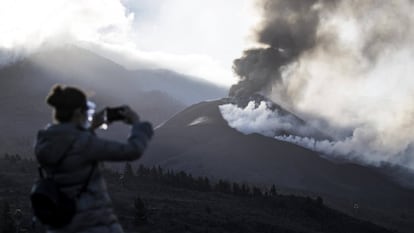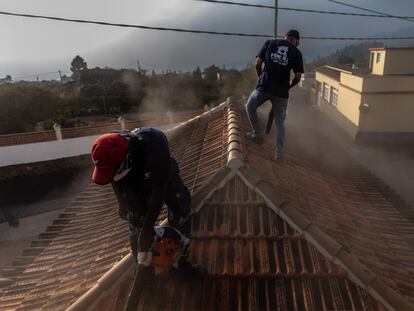La Palma eruption: Experts say ‘deepest’ magma reserves are falling
Seismic activity has eased and sulfur dioxide emissions are dropping, but scientists say more time must pass before the downward trend can be confirmed

The lava flowing from the new volcano on La Palma, in Spain’s Canary Islands, is coming out closer to the surface, as magma reserves at greater depths become depleted. That’s according to the Canaries Volcano Prevention Plan (Pevolca), which is in charge of monitoring the eruption.
Speaking at a press conference on Monday, Carmen López, the spokesperson of Pevolca, said that the chemical composition of the volcanic plume, seismic activity and ground uplift all indicated that the system that supplies the volcano with more lava was “easing” and that the reserves of magma “were becoming smaller.”
“All the observable data shows that the deepest [part of the system that feeds the volcano] is becoming less active and has less capacity to provide magma, to feed the eruption for more time,” said López.
These indicators include the falling levels of sulfur dioxide and the drop in seismic activity. López, however, called for “caution,” explaining that more time must pass before the downward trend can be confirmed. The expert also pointed out that just a few days ago a ground uplift of nearly 10 centimeters was detected in an area close to a vent – an episode that indicates that the eruption is still “intense.”
Due to this slight drop in activity, the area affected by the lava only increased by 1.41 hectares on Tuesday. Since the eruption began on September 19, 985 hectares of land have been swallowed up by the lava. “The lava flows remain fairly stable, they are traveling down the central sector and moving toward the east over previous flows, without invading new areas,” said López.
The number of buildings destroyed or damaged by the molten rock has risen to 1,452, of which 1,177 were for residential use. The European observation system Copernicus, however, puts this figure at 2,722, with most of the buildings considered to be destroyed. The European system does not distinguish between different types of constructions, meaning the number is always much higher than the one offered by Spanish authorities.
Sebastián Franquis, the regional chief of the public works, transportation and housing department, announced on Monday that his office had begun delivering the first of the 18 homes bought by the regional government to address the crisis, which has left many people homeless.
Meanwhile, sulfur dioxide emissions – which are used to measure the strength of an eruption – continue to fall. According to Pevolca, levels of the gas have been falling since September 23, when record highs of more than 50,000 tons a day were recorded. Emissions, however, remain high, with between 16,600 and 23,100 tons emitted a day.
Indeed air quality in five municipalities – Los Llanos de Aridane, El Paso, Puntagorda, Tijarafe and Tazacorte – was “extremely unfavorable” on Monday, according to the regional government of the Canary Islands, which are located off the coast of northwestern Africa. The regional authorities called on all at-risk groups – including people with respiratory illnesses or heart conditions, pregnant women and children – to avoid spending long amounts of time outdoors. The concentration of suspended particles with a diameter of less than 10 micrometers was “the highest recorded” since the beginning of the eruption, said López.
Seismic activity on La Palma has also eased with respect to previous weeks, with the tremors continuing to hit the same areas and at the same depths: between 10 and 15 kilometers, and at more than 20 kilometers. The fact that there have been no surface earthquakes is a good sign, as this reduces the risk of new vents appearing away from the volcanic cone. The strongest quake to hit in the past 48 hours measured 4.6 on the Richter scale and was recorded on Sunday at 5.07pm.
Tu suscripción se está usando en otro dispositivo
¿Quieres añadir otro usuario a tu suscripción?
Si continúas leyendo en este dispositivo, no se podrá leer en el otro.
FlechaTu suscripción se está usando en otro dispositivo y solo puedes acceder a EL PAÍS desde un dispositivo a la vez.
Si quieres compartir tu cuenta, cambia tu suscripción a la modalidad Premium, así podrás añadir otro usuario. Cada uno accederá con su propia cuenta de email, lo que os permitirá personalizar vuestra experiencia en EL PAÍS.
¿Tienes una suscripción de empresa? Accede aquí para contratar más cuentas.
En el caso de no saber quién está usando tu cuenta, te recomendamos cambiar tu contraseña aquí.
Si decides continuar compartiendo tu cuenta, este mensaje se mostrará en tu dispositivo y en el de la otra persona que está usando tu cuenta de forma indefinida, afectando a tu experiencia de lectura. Puedes consultar aquí los términos y condiciones de la suscripción digital.
More information

La Palma eruption: Life among earthquakes, ashfall and noxious gases
Últimas noticias
All the effects of gentrification in one corner of Mexico’s Colonia Roma
Palestinian reporter Youmna El Sayed: ‘My family told me I had to choose between being a journalist or a mother’
Russell Tovey: ‘I was advised many times not to come out, I don’t think there was many people who’d done that — and I feel really proud that I’m one of those that did’
Merz tries to replace Macron at the helm of Europe
Most viewed
- Families demand repatriation of bodies of Colombians who died in Ukraine: ‘This war is a slaughterhouse for foreigners’
- The low-cost creative revolution: How technology is making art accessible to everyone
- Liset Menéndez de la Prida, neuroscientist: ‘It’s not normal to constantly seek pleasure; it’s important to be bored, to be calm’
- Christian Louboutin: ‘Young people don’t want to be like their parents. And if their parents wear sneakers, they’re going to look for something else’
- US sanctions against jailed cartel leader ‘El Marro’ highlight Mexico’s lack of control over its prisons










































